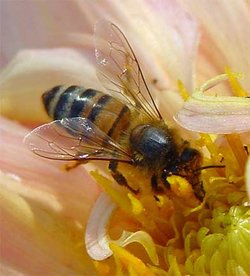Beekeeping
|
|
Beekeeping (or apiculture) is the maintenance of one or more hives of honeybees.
A beekeeper is one who keeps bees in order to collect honey and beeswax or for the purpose of pollinating crops, or to produce bees for sale to other beekeepers.
A location where bees are kept is called an apiary.
| Contents |
History of beekeeping
Beekeeping is one of the oldest forms of food production. One of the earliest examples of beekeeping is from rock painting, dating to around 13,000 b.c.. It was particularly well developed in Egypt and was dealt with by the Roman writers Virgil, Gaius Julius Hyginus, Varro and Columella.
Traditionally beekeeping was done for the bees' honey harvest, although nowadays crop pollination service can often provide a greater part of a commercial beekeeper's income. Other hive products were pollen and propolis, which were also used for nutritional and medicinal purposes, and wax which was used in candlemaking, cosmetics, wood polish and for modelling. The modern use of hive products has not changed much.
Western honeybees are not native to the Americas. Honeybees were imported by American, Australian and New Zealand colonists from Europe, partly for honey and partly for their usefulness as pollinators. The first honey bee species imported were likely European dark bees. Later italian bees, carniolan honeybees and caucasian bees were added.
Western honeybees were also brought to the Primorsky Krai in Russia by Ukrainian settlers around 1850s. These Russian honey bees that are similar to the Carniolan bee were imported into the US in 1990. The Russian honey bee has shown to be more resistant to the bee parasites, Varroa destructor and Acarapis woodi.
In the 1950s, most US hobby beekeepers were farmers or relatives of a farmer, lived in rural areas, and kept bees with techniques passed down for generations. The arrival of tracheal mites in the 1980s and varroa mites in the 1990s removed most of these beekeepers because they did not know how to deal with the new parasites and their bees died.
In Asia and Mexico other species of honeybees exist which are used by local beekeepers for honey and beeswax.
Types of beekeepers
There are several types of beekeepers:
- Hobbyists — have a different day job but find beekeeping fun as just a hobby.
- Sideliners — have other income but moonlight as "beekeepers" for extra money.
- Commercial — beekeeping is their only source of income.
Some southern US and southern hemisphere (New Zealand) beekeepers keep bees primarily to raise queens and package bees for sale. In the US, northern beekeepers can buy early spring queens and 3- or 4-pound packages of live worker bees from the South to replenish hives that die out during the winter.
In cold climates commercial beekeepers have to migrate with the seasons, hauling their hives on trucks to gentler southern climates for better wintering and early spring build-up. Many make "nucs" (small starter or nucleus colonies) for sale or replenishment of their own losses during the early spring. In the US some may pollinate squash or cucumbers in Florida or make early honey from citrus groves in Florida, Texas or California. As spring moves northward so do the beekeepers, to supply bees for tree fruits, blueberries, strawberries and later vegetables. Some commercial beekeepers alternate between pollination service and honey production but usually cannot do both at the same time.
In the Northern Hemisphere, beekeepers usually harvest honey from July until September, though in warmer climates the season can be longer.
The rest of the year is spent keeping the hive free of pests and disease, and ensuring that the bee colony has room in the hive to expand. Success for the hobbyist also depends on locating the apiary so bees have a good nectar source and pollen source throughout the year.
In the Southern Hemisphere, beekeeping is an all-the-year-round enterprise, although in cooler areas (to the south of Australia and New Zealand) the activity may be minimal in the winter (May to August). Consequently, the movement of commercial hives is more localised in these areas.
Protective clothing
When interacting with the bees novice beekeepers usually wear protective clothing (including gloves and a hooded suit or hat and veil). Experienced beekeepers do not use gloves because they make movement clumsy and can transmit disease from one hive to another. Bees are calmed with a puff of smoke, that triggers a feeding response in anticipation of possible hive abandonment due to fire, before the beekeeper opens the hive.
Types of beekeeping equipment
The bees are usually kept in a Langstroth hive, that is wooden boxes filled with frames that each hold a sheet of wax: the bees produce wax and build honeycomb using the wax sheets as a starting point, after which they may raise brood or deposit honey and pollen in the cells of the comb.
A few hobby beekeepers are adapting various top-bar hives commonly found in Africa. These have no frames and the honey filled comb is not returned to the hive after extraction, as it is in the Langstroth hive. Because of this the production of honey in a top bar hive is only about 20% that of a Langstroth hive, but the initial costs and equipment requirements are far lower. Top Bar hives also offer some advantages in interacting with the bees.


